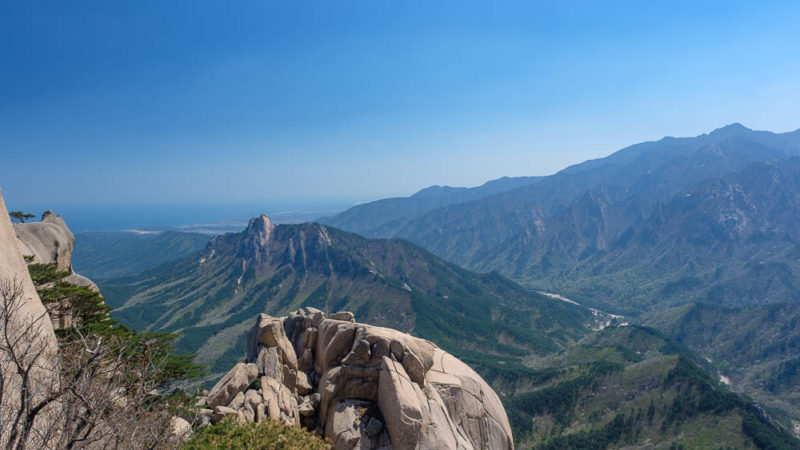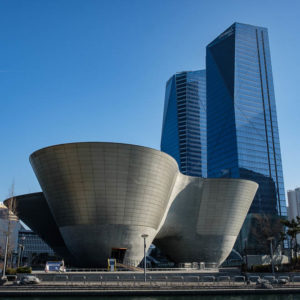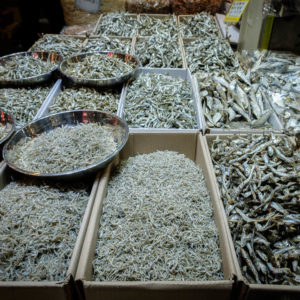As a pedestrian you still have to watch out because motorists (and to be fair, not all!) will simply run you down.
Navigating is also difficult. Google Maps only does public transport and Apple Maps knows the car and walking routes, but shows fewer locations in English. The Korean apps are working well. But obviously, they are in Korean. Fortunately, we have a car with a very good English-speaking navigation system that not only guides us neatly to our destinations, but also tirelessly warns us about the large numbers of speed cameras, average speed checks, the endless amount of speed bumps (“A speed bump is a head”, sic) and remains afraid that we will take the wrong road at every turn (“Be careful not to take the wrong road”).
The real challenge for us is the toll roads. We have already accidentally driven through them twice without paying. So there already will be a few fines waiting for us. We also found out that sometimes you can only pay with a local credit card, like in some parking garages. Standing in front of the barrier is not the best place to find out.
Our night flight from Bangkok started with quite a bit of delay and after arriving at Incheon airport the party really started. It was the first day that a new Corona regime went into effect. Anyone who has been fully vaccinated and who has entered his/her/their vaccinations into the Q-Code system was allowed to enter the country without having to go into compulsory quarantine for seven days. Easy right? We ended up waiting in all kinds of different lines for more than two hours before all checks and forms were accepted and we could look for our luggage. And then immediately on to the mandatory PCR test. They did that much more efficiently on Phuket in Thailand! On the other hand, we receive an update on the number of local Covid infections on our phone by Security Alert, every day (!), wherever we are.
Incheon is the port city located just west of Seoul. With about 3 million inhabitants, it is very large (the third largest city in the country after Seoul and Busan) and is developing rapidly. We had booked an AirBnB in Songdo, a big neighborhood with many tall buildings, modern architecture and a large park inspired by Central Park in New York. In the old center of the city you have a real Chinatown, and it is a good base for a number of parks where you can go for nice hikes. Despite the fact that spring had started, it took us some time to get used to the temperature: during the day about 20 degrees cooler than we were used to in Thailand. But, we were getting a bit tired of the heat in Thailand and we felt it was time to go hiking again. Time to adjust.
It also took some getting used to the tiny apartments here. They’re often no more than a studio of barely 25 square meters, but very efficiently furnished. Something I can’t get used to are the mini towels they give you here to dry you off with: our dishcloths at home are bigger. And don’t get me started on those extremely firm beds…
After a few days we moved on to that even bigger city, a little further east: Seoul. We had chosen an AirBnB near the large central station which makes it easy to go in any direction by bus, train or metro. The apartment was located in a building in a rather messy back alley in a residential area next to the station. How strange, we thought. But we soon found out that almost all residential areas in the city have these kind of alleys. The old lady who sat outside every day on her chair opposite our house, thought it was all interesting. When we started to say hello to her in our very best Korean, a big smile appeared.
Seoul is a very nice city. Especially if you take the time to discover new neighbourhoods. Because it’s such a huge city, you will be under way for quite some time. As soon as you get the hang of the public transport system and you have your own T-money card (a kind of public transport card), it is all very doable.We had already visited the main tourist attractions six years ago and you don’t necessarily have to see them again. That makes it fun to stroll through the nightlife district Itaewon, visit a restaurant in the student district Hongdae, walk with lots of other people under the cherry blossom in the Yeouido park or climb the tallest building in the country (555m), the Lotte World. Tower. Of course we had planned it so that our visit to Seoul would coincide with Miek’s birthday. Seoul has a number of very good restaurants with plenty Michelin stars, such as the 7th Door restaurant where we had a fantastic meal with a birthday cake as a bonus.
And speaking of cakes: Korea is also the country of dessert cafes. You can generally get pretty good coffee there, so it’s ideal for hopping in after dinner and have a cake for dessert. Just watch the calories! When you order coffee you must clearly indicate that you want it hot (otherwise you will automatically get an iced coffee) and the coffee is often a bit weak so ordering an extra shot (“You want extra hot?”) is worth it.
After about a week in Seoul we picked up the car (which we didn’t get without a bit of a fight due to some communication problems), and drove to the Hantangang River Geopark, a UNESCO site that is located northeast of Seoul. The park is actually a large area with a river flowing through it, which was created as a result of a volcanic eruption several hundred thousand years ago. There’s some good hiking here and we noticed that the Koreans you come across, a little further away from the big city, are much friendlier. You are greeted spontaneously and sometimes even spoken to. A (sort of) English speaking guide was happy to chat with us and the conversation ended in an emotional argument that South Koreans deeply sympathize with Ukraine and that they hope and expect that North and South Korea will one day be reunited. It was partly my fault that the conversation went that way. We had been hearing some loud bangs that morning, like cannon firing. Because we were near the DMZ I wanted to know what those were: they turned out to be artillery exercises…All in all a special conversation with this guide who, as we found out the hard way later after we continued our hike, could have warned us that the path we had chosen was closed halfway through, so that we had to find an alternative route with the help of Google Maps satellite images. We still believe it’s a small miracle that we didn’t end up in North Korea by accident.
The next destination was Nami Island. The beautiful island is located in a river and has become famous and popular as a destination because it appeared in several Korean movies and TV series. One of these is the “Winter Sonata” series, a hugely popular, often-referenced romantic drama that features several locations around the island where you can capture yourself (and your loved one) forever.
Seoraksan National Park is located near Sokcho, a fishing town in the far north-east of the country. We had already hiked here six years ago and we wanted to come back here again to do one of the other hikes in the park. The hard one to the top of one of the mountains, we thought. Quite a climb but it was well worth it. The beautiful spring weather certainly helped.
Since Sokcho is a fishing town, you must have sampled a traditional seafood barbecue. When we entered one of the better restaurants near our hotel, we found out that we had already eaten here before. Bu it was an extraordinary experience yet again. Did you know that Koreans simply cut their meat and fish into pieces on the barbecue with large scissors? That works a lot better than cutting.
A bit further south is the Juwangsan National Park. Also a great place for hiking through the mountains with a number of waterfalls, temples and a beautiful mini-canyon. With the climb in Seoraksan still in our legs it was a bit hard but, because we were there on a Monday, it was a lot quieter. We hardly encountered any other hikers.
The next stop was Gyeongju, a bit further south. It is a place with many burial mounds from the time of the Silla kingdom that existed from 57 BC. until the year 935. Those hills are bizarrely large and dominate the landscape of the city. You also have a large neighborhood with traditional buildings that have almost all been transformed into shops, coffee shops or restaurants, but that is still pleasnt to stroll around in.
We have now arrived in Busan, with almost 3.5 million inhabitants, the second largest city and the most important port in the country, in the south-east of the peninsula. Despite being a huge city, it’s a little more laid-back than Seoul. We have moved into an AirBnB apartment near the lively Seomyeon district where you have excellent restaurants and where, especially on weekends, it’s fun to watch the throngs of (young) people who come together to go out. The city also has a number of nice beaches, including the famous Haeundae beach, but also, as we found out by accident, cozy Gwangalli Beach with a real boulevard and a lot of full terraces from where you have a good view of the beautifully lit giga Gwangan bridge. with fireworks. Always fun.And no, we didn’t go to Busan by train. Too many zombies…







